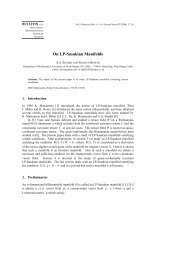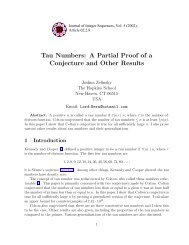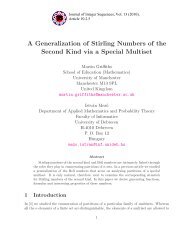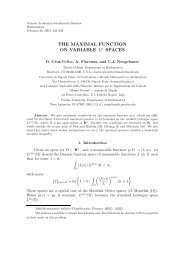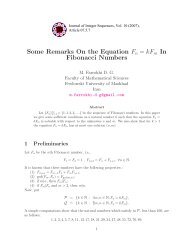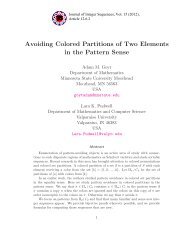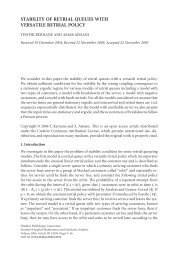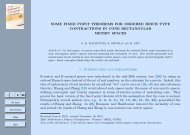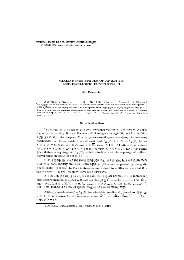Using Bonse's Inequality to Find Upper Bounds on Prime Gaps
Using Bonse's Inequality to Find Upper Bounds on Prime Gaps
Using Bonse's Inequality to Find Upper Bounds on Prime Gaps
You also want an ePaper? Increase the reach of your titles
YUMPU automatically turns print PDFs into web optimized ePapers that Google loves.
2 The relati<strong>on</strong>ship log(Γ(p k )) has <str<strong>on</strong>g>to</str<strong>on</strong>g> the upper boundp 1120 −δkand other c<strong>on</strong>clusi<strong>on</strong>s.Table 1 suggests that our formula for Γ(p k ) indeed is an upper bound for g(p k ), as k getslarge. Also from Table 1 <strong>on</strong>e can see that the fast rate of increase of Γ(p k ) by far exceeds theslower rate of increase of (log(p k )) 2 . Hence it could be interesting <str<strong>on</strong>g>to</str<strong>on</strong>g> investigate by computerthe behavior of the three respective functi<strong>on</strong>s Γ(p k ), g(p k ) and (log(p k )) 2 , where (log(p k )) 2by Cramér’s c<strong>on</strong>jecture is such that for large k,gaps.Rankin [2] showed that there exists a real c<strong>on</strong>stant c such thatp k+1 −p k(log(p k )) 2 = O(1) is true for maximal primec(log k)(log log k)(log log log log k)(log log log k) 2 < p k+1 − p k . (6)Combined with the result from Theorem 3, this indicates that for large integer k ≫ 4, takenlarge enough so that p k and p k+1 both are very large, each term of the prime differencesequence ∆p k is bounded, for each such k, asc(log k)(log log k)(log log log log k)(log log log k) 2< p k+1 − p k< p k( ∏ k−1i=1 p i − p k )log((k + 1) k+1 k k ) = Γ(p k) + 1.Let, for some real c<strong>on</strong>stant c and for any fixed integer k = k 0 ≫ 4,a(k 0 ) = c log(k 0) log log(k 0 ) log log log log(k 0 )(log log log(k 0 )) 2 − 1, (7)b(k 0 ) = p k 0( ∏ k 0 −1i=1 p i − p k0 )log((k 0 + 1) k 0+1k k 00 ) − 1 = Γ(p k 0). (8)Then it follows from Theorem 3 that, for each such positive integer k = k 0 ≫ 4, the valuefor the prime gap g(p k0 ) lies inside an open interval (a(k 0 ),b(k 0 )) <strong>on</strong> the real line.Remarks: The upper bound Γ(p k ) found in Secti<strong>on</strong> 1 and which appears <strong>on</strong> the real linein Eq. 8 as b(k 0 ) for any large fixed integer k 0 ≫ 4 such that g(p k0 ) ∈ (a(k 0 ),b(k 0 )) ⊆ R 1 ,admittedly, is a large upper bound. This actually can be an advantage. We now can comparethe values of g(p k ) <str<strong>on</strong>g>to</str<strong>on</strong>g> those for log(Γ(p k ), log log(Γ(p k )) and log log log(Γ(p k )). In fact aninspecti<strong>on</strong> of Tables 2 and 3 shows it might be profitable <str<strong>on</strong>g>to</str<strong>on</strong>g> compare the values of log(Γ(p k )),log log(Γ(p k )) and log log log(Γ(p k )) <str<strong>on</strong>g>to</str<strong>on</strong>g> those for g(p k ), ∆p k and (log(p k )) 2 , whenever k > 4is large enough so that both p k and p k+1 are two very large c<strong>on</strong>secutive primes. This isbecause <strong>on</strong>e should be able <str<strong>on</strong>g>to</str<strong>on</strong>g> find by computer that log(Γ(p k )) > g(p k ), log(Γ(p k )) > ∆p kand log(Γ(p k )) > (log(p k )) 2 as k grows large, after which <strong>on</strong>e even might be able <str<strong>on</strong>g>to</str<strong>on</strong>g> prove4



